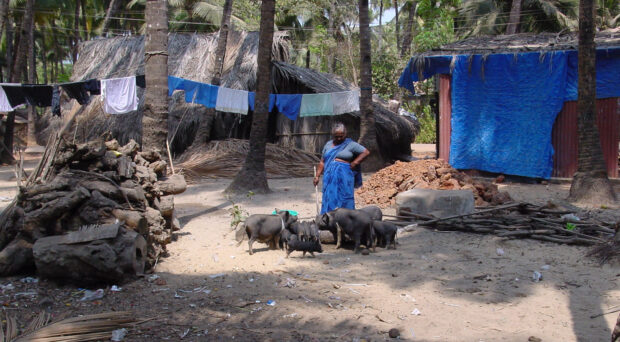
Infection with the larval stages of Taenia solium, the pork tapeworm, is one of the leading causes of acquired epilepsy in endemic countries. T. solium is a parasitic worm of medical and veterinary importance: it cases Taeniasis and Cysticersosis which together are classed as a Neglected Tropical Disease and a neglected parasitic zoonosis by the World Health Organization (WHO) and the Food and Agriculture Organization of the United Nations (FOA). Infections in pigs (porcine cysticercosis) is a notifiable animal health disease according to the World Organization for Animal Health.
Life cycle
T. solium is a type of zoonotic disease where the human is the definitive host that passes on the infection to the non-human animal, in this case, the pig. Pigs are intermediate hosts, becoming infected when they ingest T. solium eggs , often from the ground or from vegetation that has been contaminated with human faeces containing the eggs. Once in the pig T. solium eggs hatch and the onchosphere (larval stage) penetrates the intestinal wall and migrates to the striated muscle tissue, where it develops into a cysticercus. Humans become infected when they ingest this larval stage (the cysticercus) when they eat raw or undercooked pork. This infection is called Taeniasis. Once ingested, the cysticercus reaches the human intestine, the scolex attaches to the small intestine, proglottids form and it grows into an adult tapeworm. Tapeworms are hermaphrodites (both sexes) and can self-fertilize. In fact, each proglottid can contain tens of thousands of embryonated eggs (called gravid proglottids). These proglottids are shed into the intestine. The eggs and the proglottids are released into the environment through defaecation. The eggs can remain viable for months on vegetation, soil and in water. If a pig ingests them then the cycle continues.

Medical, veterinary and socio-economic importance.
Whilst taeniasis in humans is generally considered a relatively mild disease, characterised by some abdominal pain and diarrhoea or constipation, there is another side of T. solium that is very dangerous for human health. In the “normal” primary cycle humans become infected with T. solium larval stages (cysticeri) when they ingest undercooked pork. However, there is another way humans can become infected, through the faecal-oral route, by ingesting T. solium eggs. Often this faecal-oral route occurs in areas where water, sanitation and hygiene structures and practices are lacking, so infection may occur by ingesting contaminated vegetables or crops, or directly if hands aren’t washed prior to eating, or handling human waste etc. If eggs are ingested by humans, instead of pigs, the development and migration of the larval stages and formation of the cystercerci in human tissue leads to a dangerous disease called human cysticercosis, with a high risk of the cystercerci forming in the brain leading to Neurocysticercosis.
Neurocysticercosis is characterised by severe headaches, blindness, seizures, epilepsy and other neurological disorders, and can be fatal. It is estimated to affect between 2.5 and 8.3 million people annually, and is considered one of the leading causes of acquired epilepsy in endemic areas. In poor and remote settings, diagnosis and treatment for epilepsy is difficult to access and it is associated with high stigma and isolation.
Human taeniasis can be treated with praziquantel, niclosamide or albendazole. However, the treatment of neurocysticercosis has to be managed carefully because the resulting inflammation caused by degeneterating cycsts can lead to epileptic seizures. The WHO had produced a guide for the management of neurocysticercosis.
T. solium is most prevalent in low- and middle-income countries in Africa, Latin America and in South and South-East Asia. The WHO released an updated endemicity map for T. solium in 2022 showing that of the 196 countries assessed, 51 were endemic, 14 suspected endemic, 21 had a few pigs potentially exposed and 55 countries as not endemic. They did highlight that many countries had insufficient data, some with potential transmission occurring in localised communities.
Control and Management underpinned by research.
To control and manage T. solium the following cross-sector approaches are recommended:
- Treat and vaccinate pigs to prevent solium cysticerci – whilst we do not have a human vaccine there are in fact a number of effective vaccines for pigs, and studies have shown that combining vaccination with TSOL18 vaccine and anthelmintic treatment with Oxfendazole results in a 99.7% protection against subsequent T. solium infections which could significantly reduce the prevalence of porcine cysticercosis. However, studies in Uganda have shown that there needs to be a financial benefit or market value of vaccinated pigs in order to get buy-in from pig-farmers.
- Inspect meat and ensure sufficient cooking of pork.
- Improved animal husbandry for pigs to prevent exposure to human faeces.
- Improve and strengthen Water, Sanitation and Hygiene (WASH) infrastructure and practices to prevent solium contamination and infection.
- Treat human taeniasis to reduce transmission.
There is a need for better data and mapping of T. solium in order to understand spatial distribution and transmission patterns, which would help guide targeted interventions.
A key need is improved diagnostics for mapping, surveillance and clinical management of neurocysticercosis. Diagnosis of human taeniasis largely relies on microscopy using stool samples, which are not sensitive or species-specific. There are some serological tests available for human taeniasis and cysticercosis. Porcine cysticercosis relies on tongue palpation and meat inspection both of which have low sensitivity.
Generally, current serological diagnostic tests for porcine and human cysticercosis are not cost effective, have low sensitivity and are not accessible or commercially available in many low- and middle-income countries where T. solium is endemic. The WHO published a set of Target product profiles for the diagnosis of T. solium infections, defining the needed characteristics and use of the diagnostic tests:
- Taeniasis in humans caused by T. solium. A point-of-care test to be used mainly for surveillance.
- Taeniasis in humans caused by T. solium. A test with high specificity and sensitivity (various platforms) to be used to monitor control programmes.
- Human neurocysticercosis. A point-of-care test to identify symptomatic patients with viable cysts who need to be referred for confirmation by brain imaging.
- Porcine cysticercosis. A test (various platforms) to be used to monitor control programmes.
The WHO also convened a meeting of experts in 2022 to review the use of existing diagnostic tools for T. solium in public health programmes, highlighting the crucial need for appropriate diagnostics, and investments in research and capacity building.
There are some interesting advances as highlighted in this recent paper but more research and development is needed.
In the meantime, the WHO has launched a free online course and toolbox for the control and management of T. solium.

Comments